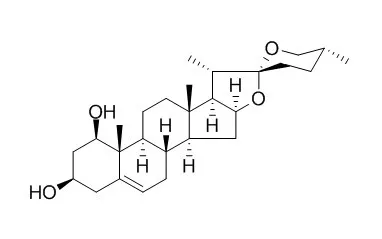| Kinase Assay: |
| Eur J Pharmacol. 2013 Aug 15;714(1-3):303-11. | | Ruscogenin reduces cerebral ischemic injury via NF-κB-mediated inflammatory pathway in the mouse model of experimental stroke.[Pubmed: 23911884] | Transient cerebral ischemia initiates a complex series of inflammatory events, which has been associated with an increase in behavioral deficits and secondary brain damage. Ruscogenin is a major steroid sapogenin in the traditional Chinese herb Ophiopogon japonicus that have multiple bioactivities. Recent studies have demonstrated that Ruscogenin is involved in down-regulation of intercellular adhesion molecule-1 (ICAM-1) and nuclear factor-κB (NF-κB) activation in anti-inflammatory pathways.
METHODS AND RESULTS:
We hypothesized that Ruscogenin protects against brain ischemia by inhibiting NF-κB-mediated inflammatory pathway. To test this hypothesis, adult male mice (C57BL/6 strain) were pretreated with Ruscogenin and then subjected to transient middle cerebral artery occlusion (MCAO)/reperfusion. After 1 h MCAO and 24 h reperfusion, neurological deficit, infarct sizes, and brain water content were measured. Ruscogenin markedly decreased the infarct size, improved neurological deficits and reduced brain water content after MCAO. The activation of NF-κB Signaling pathway was observed after 1h of ischemia and 1h of reperfusion, and Ruscogenin significantly inhibited NF-κB p65 expression, phosphorylation and translocation from cytosol to nucleus at this time point in a dose-dependent manner. NF-κB DNA binding activity, and the expression of NF-κB target genes, including ICAM-1, inducible nitric oxide synthase (iNOS), cyclooxygenase (COX-2), tumor necrosis factor-α (TNF-α) and interleukin-1β (IL-1β), were also suppressed by Ruscogenin pretreatment after 1 h MCAO and 24 h reperfusion.
CONCLUSIONS:
The results indicated that Ruscogenin protected the brain against ischemic damage caused by MCAO, and this effect may be through downregulation of NF-κB-mediated inflammatory responses. | | J. Steroid Biochem., 2015, 154:85-93. | | Ruscogenin suppresses mouse neutrophil activation: Involvement of protein kinase A pathway.[Reference: WebLink] | Ruscogenin, a natural steroidal sapogenin, presents in both food and medicinal plants. It has been found to exert significant anti-inflammatory activities.
METHODS AND RESULTS:
Considering that activation of neutrophil is a key feature of inflammatory diseases, this study was performed to investigate the inhibitory effect of Ruscogenin and its underlying mechanisms responsible for neutrophil activation. Moreover, Ruscogenin inhibited phosphorylation of protein kinase B (Akt), p38 mitogen-activated protein kinase (p38MAPK), extracellular signal-regulated kinase 1 and 2 (ERK1/2), and c-Jun N-terminal kinase (JNK). In addition, the inhibitory effects of Ruscogenin on superoxide production and the phosphorylation of Akt, p38MAPK, and ERK1/2 were reversed by PKA inhibitor (H89), suggesting a PKA-dependent mechanism.
CONCLUSIONS:
In summary, our data suggest that Ruscogenin inhibits activation of neutrophil through cPLA2, PAK, Akt, MAPKs, cAMP, and PKA signaling pathways. Increased PKA activity is associated with suppression of the phosphorylation of Akt, p38MAPK, and ERK1/2 pathways. |
|
| Cell Research: |
| Int Immunopharmacol. 2012 Jan;12(1):88-93. | | Ruscogenin inhibits lipopolysaccharide-induced acute lung injury in mice: involvement of tissue factor, inducible NO synthase and nuclear factor (NF)-κB.[Pubmed: 22079591 ] | Acute lung injury is still a significant clinical problem with a high mortality rate and there are few effective therapies in clinic.
METHODS AND RESULTS:
Here, we studied the inhibitory effect of Ruscogenin, an anti-inflammatory and anti-thrombotic natural product, on lipopolysaccharide (LPS)-induced acute lung injury in mice basing on our previous studies. The results showed that a single oral administration of Ruscogenin significantly decreased lung wet to dry weight (W/D) ratio at doses of 0.3, 1.0 and 3.0 mg/kg 1 h prior to LPS challenge (30 mg/kg, intravenous injection). Histopathological changes such as pulmonary edema, coagulation and infiltration of inflammatory cells were also attenuated by Ruscogenin. In addition, Ruscogenin markedly decreased LPS-induced myeloperoxidase (MPO) activity and nitrate/nitrite content, and also downregulated expression of tissue factor (TF), inducible NO synthase (iNOS) and nuclear factor (NF)-κB p-p65 (Ser 536) in the lung tissue at three doses. Furthermore, Ruscogenin reduced plasma TF procoagulant activity and nitrate/nitrite content in LPS-induced ALI mice.
CONCLUSIONS:
These findings confirmed that Ruscogenin significantly attenuate LPS-induced acute lung injury via inhibiting expressions of TF and iNOS and NF-κB p65 activation, indicating it as a potential therapeutic agent for ALI or sepsis. |
|






 Cell. 2018 Jan 11;172(1-2):249-261.e12. doi: 10.1016/j.cell.2017.12.019.IF=36.216(2019)
Cell. 2018 Jan 11;172(1-2):249-261.e12. doi: 10.1016/j.cell.2017.12.019.IF=36.216(2019) Cell Metab. 2020 Mar 3;31(3):534-548.e5. doi: 10.1016/j.cmet.2020.01.002.IF=22.415(2019)
Cell Metab. 2020 Mar 3;31(3):534-548.e5. doi: 10.1016/j.cmet.2020.01.002.IF=22.415(2019) Mol Cell. 2017 Nov 16;68(4):673-685.e6. doi: 10.1016/j.molcel.2017.10.022.IF=14.548(2019)
Mol Cell. 2017 Nov 16;68(4):673-685.e6. doi: 10.1016/j.molcel.2017.10.022.IF=14.548(2019)